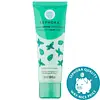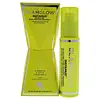What's inside
What's inside
 Key Ingredients
Key Ingredients

 Benefits
Benefits

 Concerns
Concerns

 Ingredients Side-by-side
Ingredients Side-by-side

Water
Skin ConditioningFructose
HumectantPvp
Emulsion StabilisingEthylhexyl Stearate
EmollientGlycerin
HumectantCI 77891
Cosmetic ColorantXanthan Gum
EmulsifyingPolyacrylamide
Phenoxyethanol
PreservativeC13-14 Isoparaffin
EmollientMenthyl Lactate
MaskingLaureth-7
EmulsifyingEthylhexyl Methoxycinnamate
UV AbsorberDisodium EDTA
Ethylhexylglycerin
Skin ConditioningPoloxamer 338
EmulsifyingParfum
MaskingBHT
AntioxidantEthylhexyl Salicylate
UV AbsorberButyl Methoxydibenzoylmethane
UV AbsorberCI 77492
Cosmetic ColorantPPG-51/Smdi Copolymer
Mentha Piperita Leaf Extract
Skin ConditioningCitric Acid
BufferingCI 42090
Cosmetic ColorantSodium Benzoate
MaskingPotassium Sorbate
PreservativeSodium Citrate
BufferingTocopherol
AntioxidantWater, Fructose, Pvp, Ethylhexyl Stearate, Glycerin, CI 77891, Xanthan Gum, Polyacrylamide, Phenoxyethanol, C13-14 Isoparaffin, Menthyl Lactate, Laureth-7, Ethylhexyl Methoxycinnamate, Disodium EDTA, Ethylhexylglycerin, Poloxamer 338, Parfum, BHT, Ethylhexyl Salicylate, Butyl Methoxydibenzoylmethane, CI 77492, PPG-51/Smdi Copolymer, Mentha Piperita Leaf Extract, Citric Acid, CI 42090, Sodium Benzoate, Potassium Sorbate, Sodium Citrate, Tocopherol
Water
Skin ConditioningAloe Barbadensis Leaf Juice
Skin ConditioningSodium C14-16 Olefin Sulfonate
CleansingBentonite
AbsorbentGlycerin
HumectantKaolin
AbrasiveHamamelis Virginiana Water
AstringentCaprylic/Capric Triglyceride
MaskingEthyl Perfluorobutyl Ether
SolventSodium Cocoamphoacetate
CleansingCocamidopropyl Betaine
CleansingEthyl Perfluoroisobutyl Ether
SolventNiacinamide
SmoothingSodium Hyaluronate
HumectantAvena Sativa Kernel Extract
AbrasivePyrus Malus Fruit Extract
Skin ConditioningAllantoin
Skin ConditioningAcetyl Glucosamine
Skin ConditioningBisabolol
MaskingDipotassium Glycyrrhizate
HumectantEthylhexylglycerin
Skin ConditioningMenthol
MaskingPPG-26-Buteth-26
Skin ConditioningCocamidopropyl Hydroxysultaine
CleansingSodium Chloride
MaskingXanthan Gum
EmulsifyingButyl Methoxydibenzoylmethane
UV AbsorberEthylhexyl Salicylate
UV AbsorberEthylhexyl Methoxycinnamate
UV AbsorberPentylene Glycol
Skin ConditioningCitric Acid
BufferingPropanediol
SolventPEG-40 Hydrogenated Castor Oil
EmulsifyingBHT
AntioxidantChlorphenesin
AntimicrobialPhenoxyethanol
PreservativePotassium Sorbate
PreservativeCI 77891
Cosmetic ColorantCI 60730
Cosmetic ColorantWater, Aloe Barbadensis Leaf Juice, Sodium C14-16 Olefin Sulfonate, Bentonite, Glycerin, Kaolin, Hamamelis Virginiana Water, Caprylic/Capric Triglyceride, Ethyl Perfluorobutyl Ether, Sodium Cocoamphoacetate, Cocamidopropyl Betaine, Ethyl Perfluoroisobutyl Ether, Niacinamide, Sodium Hyaluronate, Avena Sativa Kernel Extract, Pyrus Malus Fruit Extract, Allantoin, Acetyl Glucosamine, Bisabolol, Dipotassium Glycyrrhizate, Ethylhexylglycerin, Menthol, PPG-26-Buteth-26, Cocamidopropyl Hydroxysultaine, Sodium Chloride, Xanthan Gum, Butyl Methoxydibenzoylmethane, Ethylhexyl Salicylate, Ethylhexyl Methoxycinnamate, Pentylene Glycol, Citric Acid, Propanediol, PEG-40 Hydrogenated Castor Oil, BHT, Chlorphenesin, Phenoxyethanol, Potassium Sorbate, CI 77891, CI 60730
Ingredients Explained
These ingredients are found in both products.
Ingredients higher up in an ingredient list are typically present in a larger amount.
BHT is a synthetic antioxidant and preservative.
As an antioxidant, it helps your body fight off free-radicals. Free-radicals are molecules that may damage your skin cells.
As a preservative, it is used to stabilize products and prevent them from degrading. Specifically, BHT prevents degradation from oxidation.
The concerns related to BHT come from oral studies; this ingredient is currently allowed for use by both the FDA and EU.
However, it was recently restricted for use in the UK as of April 2024.
Learn more about BHTAlso known as Avobenzone, this ingredient is a chemical sunscreen filter that provides protection in the UV-A range.
Avobenzone is globally approved and is the most commonly used UV-A filter in the world.
Studies have found that avobenzone becomes ineffective when exposed to UV light (it is not photostable; meaning that it breaks down in sunlight). Because of this, formulations that include avobenzone will usually contain stabilizers such as octocrylene.
However, some modern formulations (looking at you, EU!) are able to stabilize avobenzone by coating the molecules.
Avobenzone does not protect against the UV-B range, so it's important to check that the sunscreen you're using contains other UV filters that do!
The highest concentration of avobenzone permitted is 3% in the US, and 5% in the EU.
Learn more about Butyl MethoxydibenzoylmethaneCi 77891 is a white pigment from Titanium dioxide. It is naturally found in minerals such as rutile and ilmenite.
It's main function is to add a white color to cosmetics. It can also be mixed with other colors to create different shades.
Ci 77891 is commonly found in sunscreens due to its ability to block UV rays.
Learn more about CI 77891Citric Acid is an alpha hydroxy acid (AHA) naturally found in citrus fruits like oranges, lemons, and limes.
Like other AHAs, citric acid can exfoliate skin by breaking down the bonds that hold dead skin cells together. This helps reveal smoother and brighter skin underneath.
However, this exfoliating effect only happens at high concentrations (20%) which can be hard to find in cosmetic products.
Due to this, citric acid is usually included in small amounts as a pH adjuster. This helps keep products slightly more acidic and compatible with skin's natural pH.
In skincare formulas, citric acid can:
While it can provide some skin benefits, research shows lactic acid and glycolic acid are generally more effective and less irritating exfoliants.
Most citric acid used in skincare today is made by fermenting sugars (usually from molasses). This synthetic version is identical to the natural citrus form but easier to stabilize and use in formulations.
Read more about some other popular AHA's here:
Learn more about Citric AcidEthylhexyl Methoxycinnamate is an organic compound that provides UVB protection. It often goes by the more common name of octinoxate. It is created from methoxycinnamic acid and 2-ethylhexanol.
Ethylhexyl Methoxycinnamate absorbs UVB rays with wavelengths between 280-320 nm. UV absorbers protect your skin by using chemical reactions to convert UV rays into heat and energy.
UVB (290-320 nm) rays emit more energy than UVA rays. They are capable of damaging DNA, causing sunburns and are thought to be linked to skin cancer.
The state of Hawaii has banned sunscreens containing octinoxate due to its potential impact on coral reefs. More research is needed to bridge gaps in this research. The European Union allows higher levels of octinoxate in sunscreens than the US and Australia.
Ethylhexyl Methoxycinnamate is oil soluble. It is not stable and may lose efficacy when exposed to sunlight.
Learn more about Ethylhexyl MethoxycinnamateEthylhexyl Salicylate is an organic compound used to block UV rays. It primarily absorbs UVB rays but offers a small amount of UVA protection as well.
Commonly found in sunscreens, Ethylhexyl Salicylate is created from salicylic acid and 2-ethylhexanol. You might know salicylic acid as the effective acne fighter ingredient and BHA.
The ethylhexanol in this ingredient is a fatty alcohol and helps hydrate your skin, similar to oils. It is an emollient, which means it traps moisture into the skin.
According to manufacturers, Ethylhexyl Salicylate absorbs UV wavelength of 295-315 nm, with a peak absorption at 307-310 nm. UVA rays are linked to long term skin damage, such as hyperpigmentation. UVB rays emit more energy and are capable of damaging our DNA. UVB rays cause sunburn.
Learn more about Ethylhexyl SalicylateEthylhexylglycerin (we can't pronounce this either) is commonly used as a preservative and skin softener. It is derived from glyceryl.
You might see Ethylhexylglycerin often paired with other preservatives such as phenoxyethanol. Ethylhexylglycerin has been found to increase the effectiveness of these other preservatives.
Glycerin is already naturally found in your skin. It helps moisturize and protect your skin.
A study from 2016 found glycerin to be more effective as a humectant than AHAs and hyaluronic acid.
As a humectant, it helps the skin stay hydrated by pulling moisture to your skin. The low molecular weight of glycerin allows it to pull moisture into the deeper layers of your skin.
Hydrated skin improves your skin barrier; Your skin barrier helps protect against irritants and bacteria.
Glycerin has also been found to have antimicrobial and antiviral properties. Due to these properties, glycerin is often used in wound and burn treatments.
In cosmetics, glycerin is usually derived from plants such as soybean or palm. However, it can also be sourced from animals, such as tallow or animal fat.
This ingredient is organic, colorless, odorless, and non-toxic.
Glycerin is the name for this ingredient in American English. British English uses Glycerol/Glycerine.
Learn more about GlycerinPhenoxyethanol is a preservative that has germicide, antimicrobial, and aromatic properties. Studies show that phenoxyethanol can prevent microbial growth. By itself, it has a scent that is similar to that of a rose.
It's often used in formulations along with Caprylyl Glycol to preserve the shelf life of products.
Potassium Sorbate is a preservative used to prevent yeast and mold in products. It is commonly found in both cosmetic and food products.
This ingredient comes from potassium salt derived from sorbic acid. Sorbic acid is a natural antibiotic and effective against fungus.
Both potassium sorbate and sorbic acid can be found in baked goods, cheeses, dried meats, dried fruit, ice cream, pickles, wine, yogurt, and more.
You'll often find this ingredient used with other preservatives.
Learn more about Potassium SorbateWater. It's the most common cosmetic ingredient of all. You'll usually see it at the top of ingredient lists, meaning that it makes up the largest part of the product.
So why is it so popular? Water most often acts as a solvent - this means that it helps dissolve other ingredients into the formulation.
You'll also recognize water as that liquid we all need to stay alive. If you see this, drink a glass of water. Stay hydrated!
Learn more about WaterXanthan gum is used as a stabilizer and thickener within cosmetic products. It helps give products a sticky, thick feeling - preventing them from being too runny.
On the technical side of things, xanthan gum is a polysaccharide - a combination consisting of multiple sugar molecules bonded together.
Xanthan gum is a pretty common and great ingredient. It is a natural, non-toxic, non-irritating ingredient that is also commonly used in food products.
Learn more about Xanthan Gum